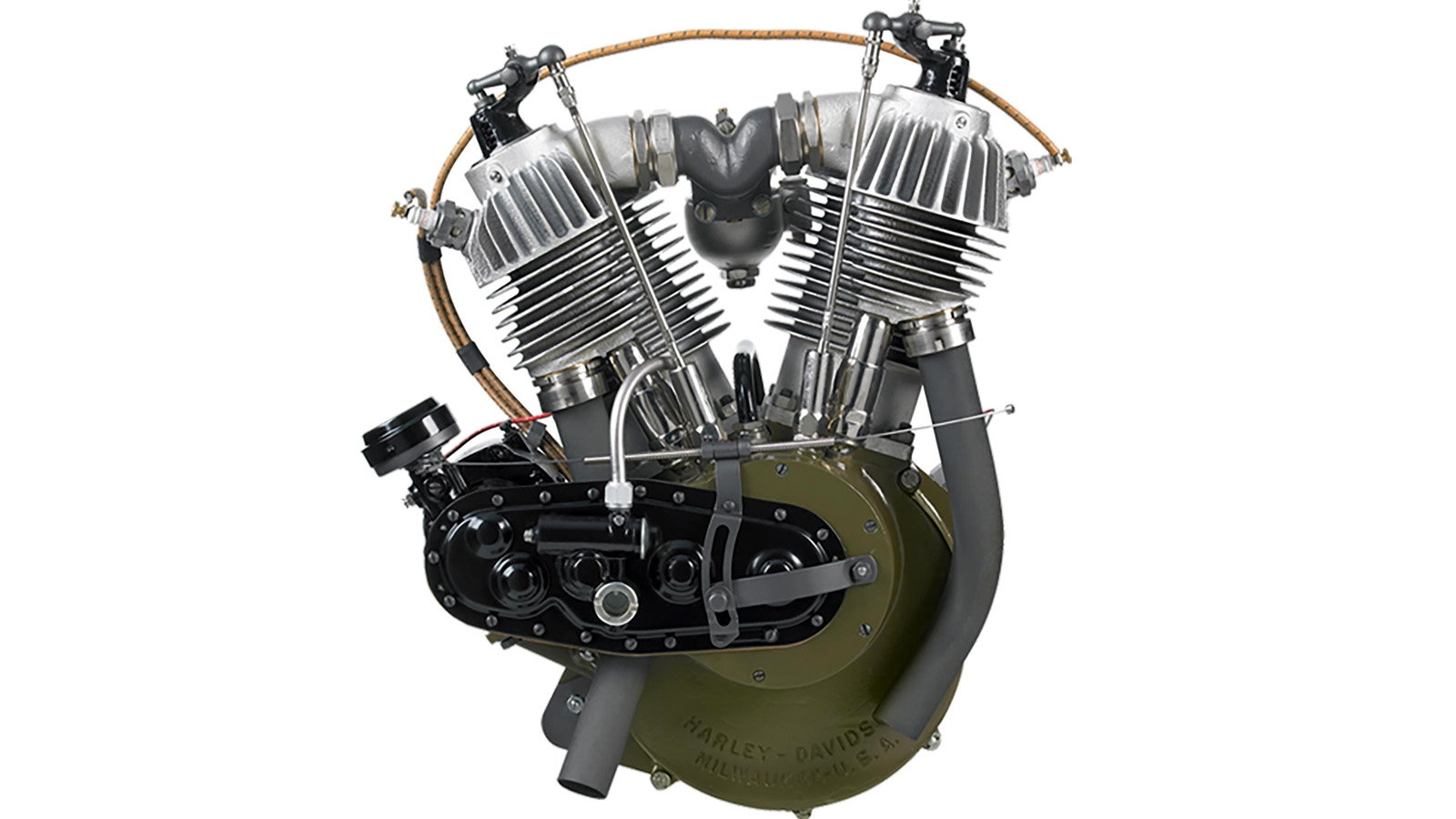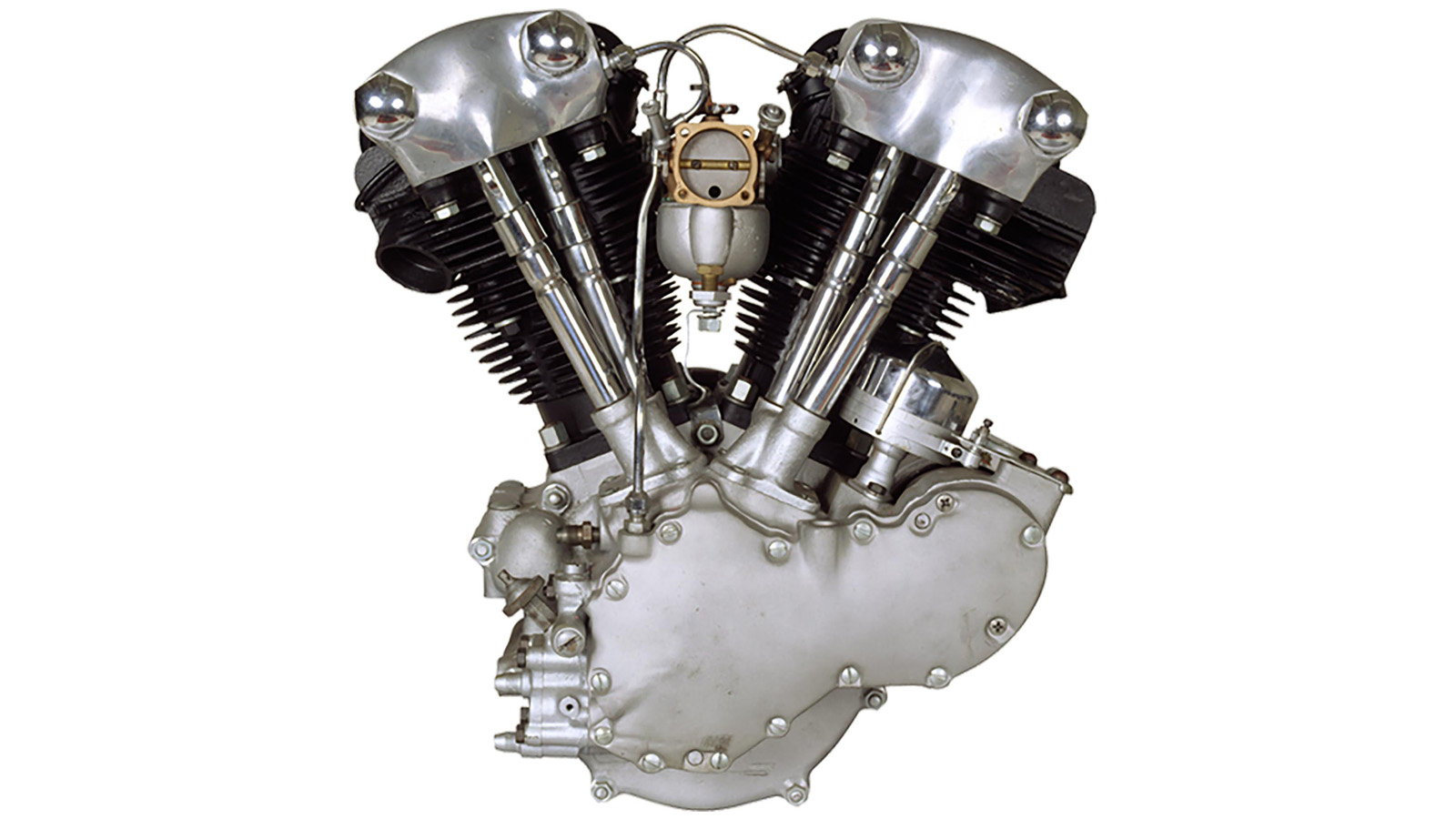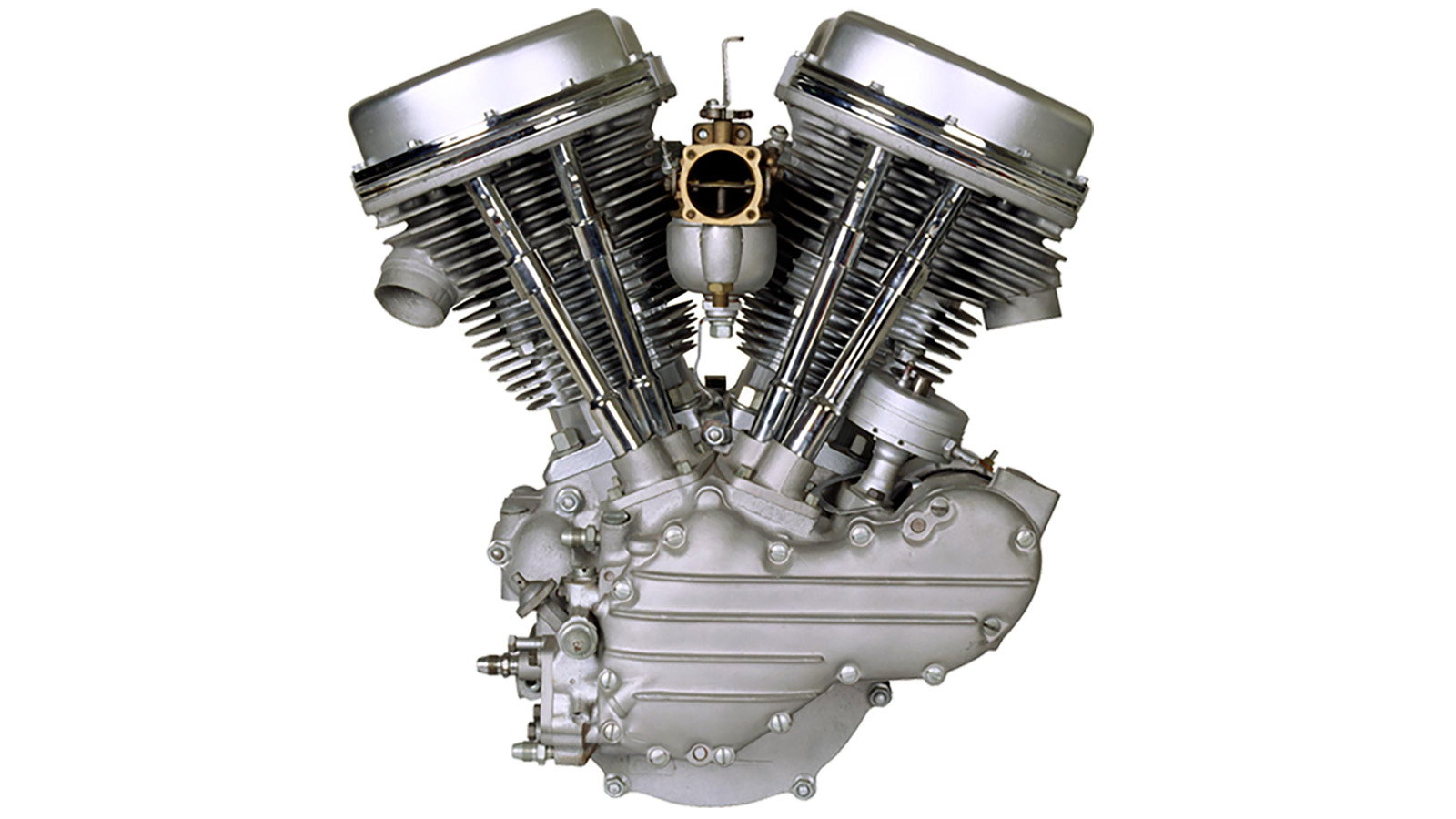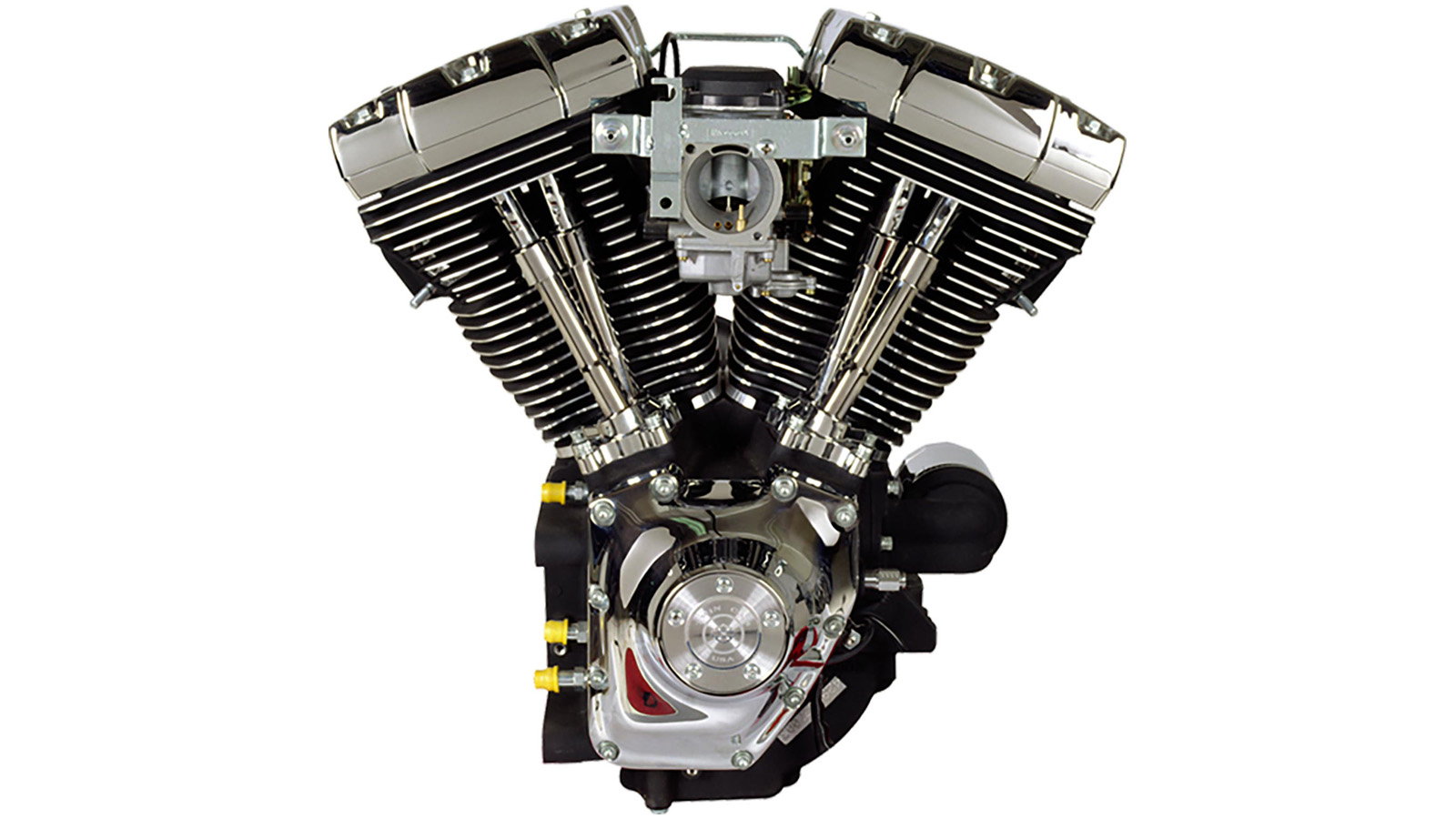110 Years of Harley-Davidson Big Twin Motors
Daily Slideshow: A brief history of Harley-Davidson's Big Twin motors from the F-Head to Milwaukee-Eight.






















History Wall
Most aficionados can name all of the Big Twin motors that Harley-Davidson has ever produced. For those that need a refresher, here is a list of all the large displacement V-Twin motors the Motor Company has manufactured over the past hundred years. For those that want the real thing, there is always the interactive 'Engine Wall' at the Harley-Davidson Museum in Milwaukee, Wisconsin.
Atmospheric V-Twin
In 1903, Harley-Davidson began manufacturing motorcycles with single cylinder engines. In 1909, the now iconic 45-degree configuration was introduced with the F-head design. These first Intake Over Exhaust, or IOE, motors did not have pushrods and relied on suction from the pistons to open the inlet valves. While the design worked well for single cylinder motors, but the atmospheric valves performed poorly on the new twin cylinder engines.
>>Join the conversation about these Big Twin Motors right here at HDForums.com!
F-head
A redesigned F-head motor replaced the seven horsepower atmospheric valve engines after only two years of production. The 1911 F-head featured external pushrods that mechanically opened the intake valves. The addition of pushrods allowed for a higher revving motor that produced eleven horsepower. The 50 cubic-inch F-head is the precursor to all modern V-Twin engines. The successful design was produced in 61 and 74 cubic-inch displacements until 1929.
>>Join the conversation about these Big Twin Motors right here at HDForums.com!
Flathead
Introduced in 1929, the side-valve 45 cubic-inch Flathead motor earned its name from its flat-topped cylinder heads. The Flathead was a rugged and reliable engine that was simple to manufacture. With no valves in the cylinder head, the engine was also easy to service. The 74 cubic-inch V-series was introduced 1930, and the 80 cubic-inch U-series in 1937. Powering the Servi-Car, the Flathead remained in production, alongside other motors, until it went out of service in 1973.
>>Join the conversation about these Big Twin Motors right here at HDForums.com!
Knucklehead
Originally referred to as the OHV or E-model, the 61 and 74 cubic-inch Knucklehead was produced from 1936-1947. With enclosed overhead valves and a dry sump, recirculating oil system, the Knucklehead holds the distinction of establishing the basic configuration of all modern V-Twins to date. The Knucklehead moniker originates from the 'clenched fist' appearance of the rocker boxes but was not coined until the arrival of the Panhead motor in 1948.
>>Join the conversation about these Big Twin Motors right here at HDForums.com!
Panhead
With rocker box covers resembling cake pans, the Panhead was produced in 61 and 74 cubic-inch versions from 1948 to 1965. While subjective, the Panhead is considered to be one of the more attractive Big Twin motors Harley-Davidson has ever produced. Panheads were a blend of old and new technology. Benefiting from metallurgical advancements during WW2, the heads were now aviation-strength aluminum, while the cylinders were still cast-iron. The bottom-end also still retained the older 'slabside' design of the Knucklehead.
>>Join the conversation about these Big Twin Motors right here at HDForums.com!
Shovelhead
Produced from 1966 to 1984, the Shovelhead engine was manufactured in 74 and 80 cubic-inch versions. Late model shovelheads are known as 'cone' motors because of the redesigned cases that accommodated the alternator behind the primary drive. Plagued by problems from the low-octane gas in the 1970s, the Shovelhead has the dubious honor of powering Harley-Davidson through the American Machine and Foundry (AMF) years and surviving the onslaught of cheaper import motorcycles.
>>Join the conversation about these Big Twin Motors right here at HDForums.com!
Evolution
The 80 cubic-inch Evolution motor was delivered in 1984, and despite some efforts, the name 'Blockhead' never really stuck as a nickname. The Evolution or 'Evo' as it is commonly known, was credited with keeping Harley-Davidson from bankruptcy after the 1981 buy-back from the AMF. The most remarkable feature of the new Evolution engines was the all-aluminum design, which translated into a more reliable and cooler running engine, with tighter tolerances. The Evolution was a thoroughly modern engine — the Motor Company had come of age.
>>Join the conversation about these Big Twin Motors right here at HDForums.com!
Twin-Cam
The 88 cubic-inch Twin-Cam was released in 1999. Originally planned for 1997, the P-22, later called the Twin-Cam, was delayed by oil temperature issues and the rejection of an oil cooler by the Motor Company's styling department. The Twin-Cam, aptly named for its dual chain-driven cam configuration, was offered in 88, 96, 103, and 110 cubic-inch capacities until 2017 when Harley-Davidson introduced the paradigm-shifting all Softail line-up and the new Milwaukee-Eight engine.
>>Join the conversation about these Big Twin Motors right here at HDForums.com!
Milwaukee-Eight
Named after the Motor Company's home town and the number of valves, the Milwaukee-Eight is yet another technological step forward for Harley-Davidson. First released in the 2017 touring models, the Milwaukee-Eight features four valves per cylinder but returns to the single camshaft configuration of the Evolution engine. Available in 107 and 114 cubic-inch displacements, the Milwaukee-Eight is revolutionary for Harley-Davidson as it features liquid-cooled heads, and two spark plugs per cylinder.
>>Join the conversation about these Big Twin Motors right here at HDForums.com!
Revolution
First introduced in 2001, the Porsche-influenced Revolution is an anomaly in the Motor Company's line-up. With cylinders opposed at 60 degrees, rather than the usual forty-five, the 69 cubic-inch Revolution is an all liquid-cooled, dual overhead cam engine that was based on the VR-1000 Superbike — Harley Davidson's competitive drag racing motorcycle. Unlike other engine platforms, the Revolution was only available in the VRSC (V-Twin Racing Street Custom), or V-Rod. Like the Dyna line-up, production of the V-Rod ended in 2017.
>>Join the conversation about these Big Twin Motors right here at HDForums.com!
For maintenance and repair guides for your Harley, browse our technical How-to articles right here at HDForums.com!

